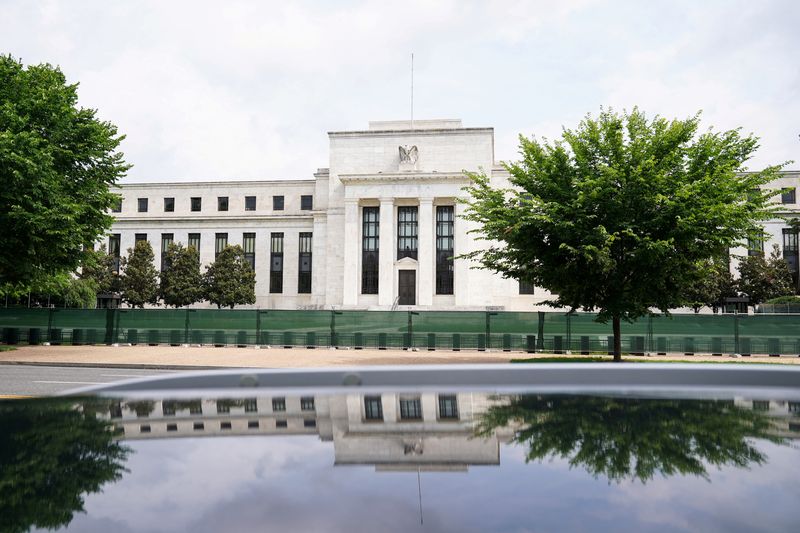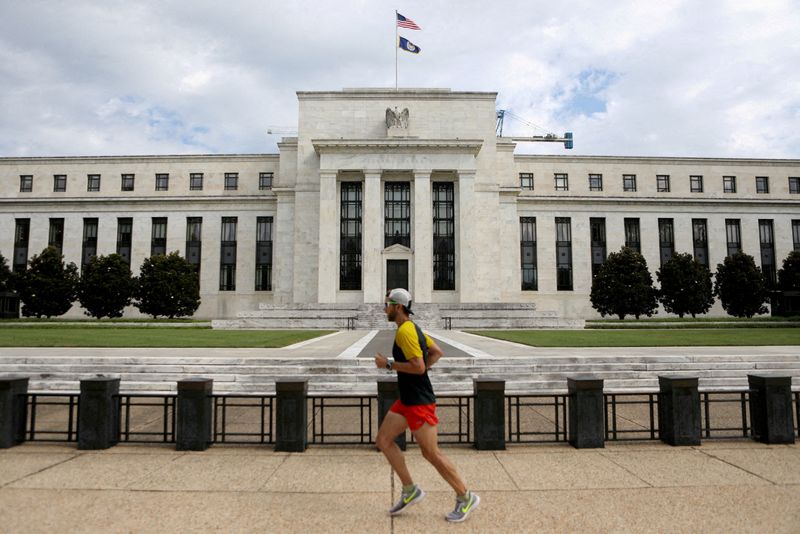By Howard Schneider
WASHINGTON (Reuters) - Federal Reserve officials gathering at the annual central banking conference in Jackson Hole, Wyoming, this week can take some satisfaction that the U.S. unemployment rate, at 4.3%, remains low by historical standards.
But it usually is: The U.S. experience of unemployment since the late 1940s has involved jobless rates that far more often than not are below the 5.7% long-run average, until they rise fast and far above it, a phenomenon Fed officials are worried about repeating.
The emerging trend is not fully clear.
The steady rise in the unemployment rate from 3.7% in January of 2023 to 4.3% as of July 2024 has also been accompanied by an increase of 1.2 million in the number of people looking for work - something that is usually considered a positive sign for the economy but that can cause the unemployment rate to rise.
In recent days, however, Fed officials have become more explicit that a potential weakening of the job market has them ready to cut interest rates after keeping the U.S. central bank's benchmark policy rate in the 5.25%-5.50% range for more than a year. The current level is the highest in a quarter of a century.
"The balance of risks has shifted, so the debate about potentially cutting rates in September is an appropriate one to have," Minneapolis Fed President Neel Kashkari said in a recent Wall Street Journal interview, referring to the central bank's Sept. 17-18 policy meeting.
Other Fed officials including San Francisco Fed President Mary Daly said in other interviews they were gaining confidence that inflation was returning to the central bank's 2% target and that they were open to rate cuts.
The Fed is widely expected to reduce its policy rate by a quarter of a percentage point next month. In addition, policymakers will provide updated projections showing how they believe rates and the economy may evolve through the rest of this year and into 2025.
Fed Chair Jerome Powell is expected to further pin down the view that the central bank is about to start to loosen credit conditions after taming the worst outbreak of inflation in 40 years when he speaks on Friday at the Kansas City Fed's Jackson Hole conference.
EYES ON OTHER MANDATE
Fed policymakers hope those cuts come in time to complete what has developed so far as a textbook "soft landing" in which inflation slows without the sort of sharp rise in the unemployment rate that has often accompanied central bank efforts to slow the pace of price increases by restricting the economy through higher interest rates. In past cycles of monetary tightening, once the unemployment rate has started to rise it has kept going.
By contrast, the progress made on inflation in the current cycle has been dramatic. The personal consumption expenditures price index, which is tracked by the Fed for its 2% inflation target, peaked at an annual rate of 7.1% in June 2022, and was running at 2.5% as of July - honing in on that target.
Yet the unemployment rate until recently had barely budged, remaining below 4% for two years running, while payrolls growth was far above the average seen in the decade before the COVID-19 pandemic.
The trend began changing this year, and Fed officials have given increasing weight to the risks they feel they are running by keeping monetary policy too tight for too long.
Recent labor market data shows why they are getting concerned.
The U.S. government reported weaker-than-expected job growth in July, with employers adding just 114,000 positions. The July reading pulled the three-month average below the pre-pandemic trend, and pushed the unemployment rate up two-tenths of a percentage point to 4.3%.
In addition, some of the ways in which the data are changing on a month-to-month basis, as people enter and leave a job or a job search, is not encouraging. While the labor force is rising on net, a constructive change, it also appears to be taking longer for people to find jobs - as shown by the rising number of people who join the labor force but go first through a spell of unemployment instead of directly into a job.
In addition, federal labor flows data shows a rising number of people each month moving from a job to unemployment.
Yet at the same time unemployment claims have not begun to rise dramatically, and in fact have kept pace with growth in the labor force.
Amid still-strong consumer spending and economic growth that may be slowing but remains positive, the Fed is not yet ready to consider the job market in crisis - it just wants to avoid creating one.

In comments to the Financial Times published on Sunday, Daly said that keeping rates high while inflation declined was a "recipe for getting the result we don't want, which is price stability and an unstable and faltering labor market."
The same sentiment was largely echoed by Chicago Fed President Austan Goolsbee, who told the CBS "Face the Nation" program on Sunday: "If you keep too tight for too long, you will have a problem on the employment side of the Fed's mandate."
